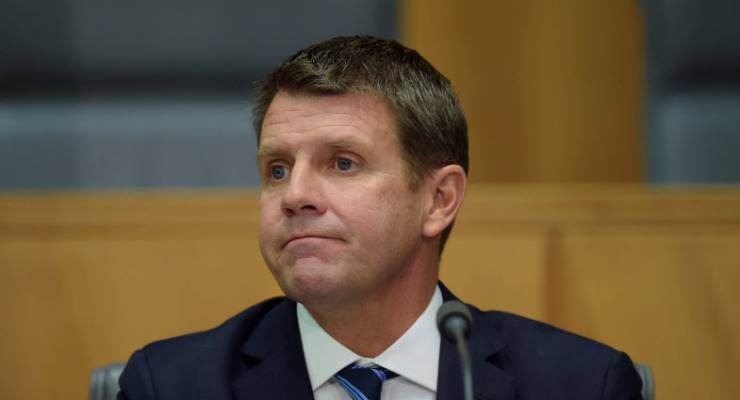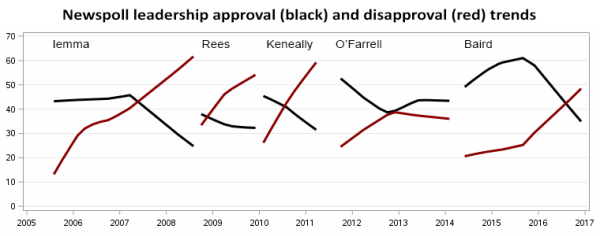
Mike Baird’s surprise resignation as New South Wales Premier makes him the fifth person to vacate the position since 2008, and the first to do so on his own terms since Bob Carr in 2005.
Given the circumstances of his departure, and his success in keeping his nose clean as leader of a state that has become proverbial for political malfeasance, most reacted to the news sympathetically (Mark Latham being a seemingly inevitable exception).
Even so, Baird leaves office with a patchy electoral record, and with recent polls suggesting the public was growing increasingly disenchanted with his leadership.
The Coalition was handily re-elected a year after Baird took office in April 2014, but such was the unprecedented scale of Barry O’Farrell’s landslide win in 2011 that the strength of his performance was hard to evaluate.
On the one hand, the Coalition emerged with a healthy majority of 54 seats out of 93 — but on the other, it lost 15 seats and suffered an advserse two-party swing of 10%.
[Baird’s resignation fires starting gun on NSW Liberal factional warfare]
Depending on how you look at it, it was either the Coalition’s worst performance at a state election in a quarter of a century, or its second best.
Fair-minded observers would incline to the more favourable view, since the gloss had already worn off the government by the time Baird succeeded O’Farrell three years into the government’s first term.
The property developer donations scandals that claimed eight Liberal scalps had introduced some element of equivalence with state Labor’s dismal record of corruption, and the government had been hammered by a 26% swing to Labor at a byelection in the Sutherland Shire seat of Miranda six months before Baird took on the job.
Furthermore, Baird has been the only premier of the post-Carr era to have substantially gained in popularity over any period while in the job — a point illustrated by the opinion poll trends displayed in the chart below — and his upward trajectory at the time of the 2015 election presumably added fat to the Coalition’s winning margin.

Certainly it’s worth observing that Baird’s victory made him only the second New South Wales Liberal leader to win a parliamentary majority since 1988, and the first to do so while seeking re-election since 1973.
However, it’s only been in the second term that things have truly turned sour, resulting in a slump in personal support all too familiar in the state’s recent political history.
Lockout laws and council amalgamations have commonly featured in aggregations of the post-election black marks against Baird’s name, but by far the biggest question mark over his political smarts relates to his banning and then unbanning of the greyhound racing industry.
This culminated in a byelection disaster in mid-November to rival that suffered by O’Farrell in Miranda, when the Nationals-held seat of Orange was lost to Shooters Fishers and Farmers, prompting Nationals leader Troy Grant to fall on his sword two days later.
[The ballad of Baird: how Teflon Mike became the big bad wolf]
Yet despite all that, the Coalition has maintained leads over Labor in every published opinion poll.
The scale of those leads has been rather modest of late — the most recent results from Newspoll and Essential Research both had it at 51-49 on two-party preferred — but this is a position that most governments would be more than happy with at the mid-point of their second term.
If storm clouds loomed on the horizon, they had less to do with Baird’s unpopularity than with tensions in a party organisation in which empire-building moderates have increasingly gained the ascendancy, to the bitter chagrin their conservative rivals.
The challenge of managing these tensions will now fall to a new leader — expected to be Gladys Berejiklian, who reportedly stands to benefit from a deal between her own moderate faction and young right up-and-comer Dominic Perrottet, who looks set to succeed her as deputy leader and treasurer.
Recent history suggests Berejiklian will come to her new role with considerable public goodwill.
But it also suggests the goodwill will be fickle and fleeting, with no guarantee that she will be able to carry it through to an election still more than two years away.








I think the Teflon had well and truly chipped off Casino Mike by the end.
It’s hard to know what’s more contemptible: his deliberate exemption of the casino(s) from the lockout zone; his cowardly about-turn on greyhound racing; or his gutless dumping of the job in someone else’s lap after such a short time.
I don’t think voters mind a resignation and transition when a Premier is into his/her third term in office, but just three years after taking on the gig seems deeply unimpressive.
More “Formica” Baird?
That Casino Mike cliche is pathetic. They were Barry O’ Farrell’s lockout laws (and the community demanded them — Sydney’s nightlife had become absolutely feral). He was simply carrying through an extremely successful, and popular (despite the backlash from partygoers on social media), public policy that was backed by evidence.
Perrottet is a fool who is selling the land titles deal. I think teflon Mike was going to smell pretty bad in another few months with the bungling of Skyrail and what not. As for Orange being about greyhounds, I don’t buy it. It is about all the money going into Sydney, rising state costs and especially council amalgamations which affect a fair bit of the electorate. THat is waiting to hit the nationals over the head in a few other seats.
NSW is Oz writ large demographically speaking – a solid concentration of seat rich megapolises, another swag of sparse hinterland trog. safe seats at growing risk from tree changers and the pig ignorant, low information morons who wouldn’t know their arse from a hole in the ground if you were hanging out of them.
Was there ever a poll of the NSW people showing broad opposition to the ban on greyhound racing or was the backlash confined to a noisy and influential minority against a population quite comfortable with the ban?